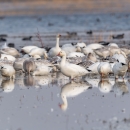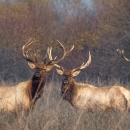About Us
The San Joaquin River National Wildlife Refuge located in Stanislaus County encompasses more than 7,300 acres of riparian riparian
Definition of riparian habitat or riparian areas.
Learn more about riparian woodlands, wetlands, and grasslands that host a diversity of wildlife native to California’s Great Central Valley. The refuge is situated where three major Valley rivers – San Joaquin, Tuolumne, and Stanislaus – join creating a mosaic of habitats that provide ideal conditions for great wildlife and plant diversity. The refuge was established in 1987 under the Endangered Species Act and the Migratory Bird Conservation Act.
The refuge has played a major role in the recovery of Aleutian cackling geese by serving as an important wintering area and continues to be of major importance to this species. By the mid-1970s, the total population of Aleutian cackling geese was fewer than 1,000. Removing nest predators from the breeding grounds in Alaska’s Aleutian Islands and improving wintering habitat in California’s Great Central Valley resulted in the goose being delisted as an endangered species and a population today well over 200,000 and growing. Restoring wetlands, and providing grasslands and croplands at this refuge has provided ideal wintering habitat for the geese.
It is estimated that ninety-five percent of the San Joaquin Valley’s riparian woodlands were lost during the last century due to changing land uses. This critical habitat is being restored on a landscape level at the refuge. Within the borders of the refuge is one of California’s largest riparian woodland restoration projects to date: more than ½ million native trees and shrubs including willows, cottonwoods, oaks, blackberry, and rose have been planted across 2,500 acres of river floodplain, creating the largest block of contiguous riparian woodland in the San Joaquin Valley. This important riparian woodland habitat supports many rare animals.
Through efforts at the refuge, there is hope the highly-endangered riparian brush rabbit will one day join the Aleutian cackling goose as a fully-recovered species. Riparian brush rabbits are endemic to the riparian woodlands of California’s Great Central Valley. By the 1990s, their numbers dwindled to near extinction because of habitat loss and degradation. The last known population was discovered along the Stanislaus River in San Joaquin County. Through a partnership with the Endangered Species Recovery Program at California State University, Stanislaus, captive-bred rabbits have been released into the refuge’s well-suited dense riparian woodlands. By establishing a new large population of rabbits, these efforts will help foster successful recovery for this endangered mammal. The refuge contains the largest population of riparian brush rabbits in the world.
A national wildlife refuge is typically a contiguous area of land and water managed by the U.S. Fish and Wildlife Service for the conservation and, where appropriate, restoration of fish, wildlife and plant resources and their habitats for the benefit of present and future generations of Americans.
Learn more about national wildlife refuge . Swainson's hawks are summer residents of the wildlife refuge, breeding in the San Joaquin Valley. The species spends the winter in South America. | Image Details
The riparian woodlands on the refuge support a diversity of bird species. Swainson’s hawks nest in the canopy of tall cottonwood trees. Herons, egrets, and cormorants form communal nesting colonies within the tops of the large valley oaks. Breeding songbirds including grosbeaks, orioles, flycatchers, and warblers nest in woodlands on the refuge.
The refuge features the 4-mile Pelican nature trail (open year-round) that meanders through seasonal wetlands, restored riparian woodlands, and stands of old-growth valley oak trees. The trailhead includes a 7-acre native vegetation free-roam exploration area. The Beckwith wildlife observation area (open seasonally) is a favorite location for viewing the Aleutian cackling geese and sandhill cranes along with other waterbirds.
Our Purpose
Every national wildlife refuge was created for a specific purpose. Some were created to protect migratory birds, others to protect threatened or endangered species, or unique habitats, while others fulfill another specific purpose. All activities allowed on refuges must be evaluated to make sure no activity conflicts with the reason the refuge was founded.
The San Joaquin River NWR was established in 1987 under the authorization of the Endangered Species Act and the Migratory Bird Conservation Act to provide wintering habitat for endangered Aleutian cackling geese.
Our Mission
The mission of the National Wildlife Refuge System is to administer a national network of lands and waters for the conservation, management and where appropriate, restoration of the fish, wildlife and plant resources, and their habitats within the United States for the benefit of present and future generations of Americans.
Our History
1987 -- San Joaquin River NWR was established.
2001 -- Aleutian cackling geese were removed (de-listed) as an endangered species under the Endangered Species Act.
2002 -- The first captive-bred riparian riparian
Definition of riparian habitat or riparian areas.
Learn more about riparian brush rabbits were released on the San Joaquin River NWR.
Other Facilities in this Complex
The San Joaquin River NWR is part of the San Luis NWR Complex. A national wildlife refuge national wildlife refuge
A national wildlife refuge is typically a contiguous area of land and water managed by the U.S. Fish and Wildlife Service for the conservation and, where appropriate, restoration of fish, wildlife and plant resources and their habitats for the benefit of present and future generations of Americans.
Learn more about national wildlife refuge complex is an administrative grouping of two or more refuges, wildlife management areas, or other refuge conservation areas that are primarily managed from a central office location. Refuges are grouped into a complex structure structure
Something temporarily or permanently constructed, built, or placed; and constructed of natural or manufactured parts including, but not limited to, a building, shed, cabin, porch, bridge, walkway, stair steps, sign, landing, platform, dock, rack, fence, telecommunication device, antennae, fish cleaning table, satellite dish/mount, or well head.
Learn more about structure because they occur in a similar ecological region, such as a watershed or specific habitat type, and have a related purpose and management needs. Typically, a project leader or complex manager oversees the general management of all refuges within the complex and refuge managers are responsible for operations at specific refuges. Supporting staff, composed of administrative, law enforcement, refuge manager, biological, fire, visitor services, and maintenance professionals, are centrally-located and support all refuges within the complex.
Other units in the San Luis NWR Complex include the San Luis NWR, Merced NWR, and Grasslands Wildlife Management Area.







